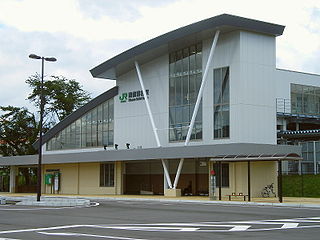
Shinjuku is a special ward in Tokyo, Japan. It is a major commercial and administrative centre, housing the northern half of the busiest railway station in the world and the Tokyo Metropolitan Government Building, the administration centre for the government of Tokyo. As of 2018, the ward has an estimated population of 346,235, and a population density of 18,232 people per km2. The total area is 18.23 km2. Since the end of the Second World War, Shinjuku has been a major secondary center of Tokyo (fukutoshin), rivaling to the original city center in Marunouchi and Ginza. It literally means "New Inn Ward".

Taiwa is a town located in Miyagi Prefecture, Japan. As of 31 May 2020, the town had an estimated population of 28,436, and a population density of 130 persons per km² in 12,016 households. The total area of the town is 225.49 square kilometres (87.06 sq mi).

Maniwa is a city located in north-central Okayama Prefecture, Japan. Its northernmost border meets that of Tottori Prefecture.

Kitty Films was a production company established in 1972 in Japan.

Rikuzen-Ochiai Station is a railway station in Aoba-ku, Sendai in Miyagi Prefecture, Japan, operated by East Japan Railway Company.
Hidehiko "Hidy" Ochiai is a Japanese-born martial arts instructor, author, and actor. He is credited with establishing the Washin-Ryu style of karate in the United States in 1966. He was the winner of the United States Grand National Karate Championship five consecutive times. Ochiai was inducted into the Black Belt Hall of Fame twice—as Instructor of the Year for Japanese Arts in 1979 and as Man of the Year in 1980. He resides in Vestal, New York

The Geibi Line is a railway line operated by West Japan Railway Company in the mountainous area of the Chūgoku region in Japan. It begins at Bitchū Kōjiro Station on the west side of Niimi, Okayama Prefecture, connecting through Miyoshi Station in Miyoshi, Hiroshima Prefecture, and terminating at Hiroshima Station in Hiroshima. In addition to the Chūgoku Expressway, the Geibi Line is considered the main commuter and local rail line covering the route between northern Hiroshima Prefecture and the city of Hiroshima. The name of the line refers to the ancient provinces of Aki (安芸) and Bitchū (備中), which the line connects.

Bingo-Ochiai Station is a JR West Geibi and Kisuki Line station in Hattori, Saijō-chō, Shōbara, Hiroshima Prefecture, Japan.
Masayuki Ochiai is a Japanese film director. His films include Kansen and Saimin.

Nemuro Main Line is a railway line in Hokkaido operated by Hokkaido Railway Company, connecting Takikawa Station in Takikawa and Nemuro Station in Nemuro, including Obihiro and Kushiro. Higashi-Nemuro is the most easterly situated station on the Japanese rail system.

Hiromitsu Ochiai is a Japanese professional baseball manager and former player. He is former manager of the Chunichi Dragons in Japan's Nippon Professional Baseball. He is considered to be one of the most important players in the history of Japanese baseball, winning numerous batting awards and being the only player to receive the prestigious triple crown batting award three times. With 510 career home runs, Ochiai is sixth on the all-time NPB list. Ochiai's style is called Oreryu(オレ流). Oreryu means "to do with only my style." The word described how he acted according to his personal philosophies.

Ochiai Station is a subway station on the Tokyo Metro Tozai Line in Shinjuku, Tokyo, Japan, operated by the Tokyo subway operator Tokyo Metro. It is numbered T-02.

Ochiai-juku was the forty-fourth of the sixty-nine stations of the Nakasendō connecting Edo with Kyoto in Edo period Japan. It is located in former Mino Province in what is now part of the city of Nakatsugawa, Gifu Prefecture, Japan.
Hiroshi Ochiai is a former Japanese football player. He played for Japan national team.

Takayuki Okada Japanese: ジャイアント落合, more widely known as Giant Ochiai, was a Japanese professional wrestler and mixed martial artist. Okada's MMA record was 3-3-2 (win–loss–draw).

The Kisuki Line is a railway line in Japan operated by West Japan Railway Company. The 81.9 km (50.9 mi) line connects Shinji in Matsue, Shimane with Bingo Ochiai in Shōbara, Hiroshima.

Shimo-Ochiai Station is a railway station on the Seibu Shinjuku Line in Shinjuku, Tokyo, Japan, operated by the private railway operator Seibu Railway.

Parasite Eve is a 1997 Japanese science fiction film that was directed by Masayuki Ochiai and is based on the 1995 novel Parasite Eve by Hideaki Sena. Kiyomi, the wife of Toshiaki Nagashima, is left brain dead after a traffic accident on the day of their first wedding anniversary. Nagashima attempts to make Kiyomi live again by making a deal with a doctor who wants to harvest Kiyomi's kidneys for transplanting into a young girl in the same hospital. Nagashima agrees on the condition that he can have his wife's liver. While Nagashima experiments with the organ, the doctor finds one night the samples have emerged as a gelatinous form in the form of Toshiaki's dead wife and reveal themselves as an organization of sentient mitochondria that are bent on making a new species that will wipe out humanity.
Hiromasa Ochiai is a Japanese field hockey player. He competed in the 2020 Summer Olympics.















